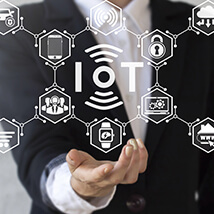The Internet of Things (IoT) connects devices across homes, businesses, and industries, bringing convenience and efficiency. Yet, while IoT introduces many benefits, it also poses serious cybersecurity risks. Understanding these risks and the strategies to counter them is essential for organizations and individuals alike.
What is IoT and Why Does it Matter?
IoT refers to physical devices that connect to the internet, collect data, and communicate with each other. This can range from smart home gadgets and wearables to industrial machines and healthcare monitors. With every new IoT device introduced, the potential for cyber threats grows, raising security challenges.
Integrating IoT into businesses, like introducing IoT to the workplace, has led to improved collaboration, automated processes, and data-driven decision-making. However, these benefits come with the need to safeguard company networks and data, especially as workplaces become more connected.
Key Cybersecurity Risks Associated with IoT
1. Expanding Attack Surface
With each device connected to a network, there’s an additional entry point for cybercriminals. Many IoT devices lack strong built-in security features, making them easy targets. For instance, the 2016 Mirai botnet attack used insecure IoT devices like cameras and routers to disrupt global services with a Distributed Denial of Service (DDoS) attack. Such incidents highlight the importance of securing IoT devices to prevent large-scale disruptions.
2. Weak Authentication Practices
Many IoT devices still use default passwords that users often forget to change. These credentials are easy for attackers to discover and exploit. Without advanced authentication methods like two-factor verification, IoT devices are left exposed to brute-force attacks, increasing the risk of unauthorized access.
3. Lack of Regular Software Updates
Software vulnerabilities are a common issue in IoT devices. Unlike traditional IT systems, IoT devices often operate on outdated firmware without frequent updates. Manufacturers typically prioritize releasing new features over improving security, which leaves devices exposed to known threats.
4. Data Privacy Concerns
IoT devices collect massive amounts of data, often including sensitive information. This can be a major privacy issue if devices are compromised or if they lack proper encryption. For instance, smart home devices track user behavior and routines, while healthcare IoT devices monitor patient health. Without encryption, this information can easily fall into the wrong hands.
5. Botnet Threats and DDoS Attacks
The rise of IoT devices has led to an increase in botnet attacks, where compromised devices are used to launch DDoS attacks. IoT devices, with their minimal processing power, can run unnoticed and act as launch pads for large-scale attacks.
Mitigation Strategies for IoT Security
To manage these risks, organizations must take a comprehensive approach. Here are five essential strategies to improve IoT security:
1. Strengthening Authentication and Password Practices
One of the most critical steps is enforcing strong, unique passwords on IoT devices. Users should be encouraged to change default credentials during setup. Adding two-factor authentication or biometric verification is essential for preventing unauthorized access.
2. Regular Software Updates and Patching Policies
Manufacturers need to prioritize consistent software updates and patches to fix vulnerabilities. Users should enable automatic updates to keep their devices protected from new threats. Companies should adopt a structured policy to monitor and deploy updates quickly, especially for essential devices.
3. Implementing Encryption Protocols
Encryption is vital to secure data in transit between devices and servers. Industries that handle sensitive data, such as finance and healthcare, must use strong encryption protocols to protect data from being intercepted.
4. Segmenting Networks to Limit Breaches
Creating isolated networks for IoT devices reduces the risk of widespread attacks. In a smart home or office, devices managing environmental controls should be on a different network from critical systems. This way, a compromised device can be contained without affecting other parts of the network.
5. Monitoring and Detection Systems
Regular monitoring of IoT devices is crucial to detect and address unusual behavior. Using intrusion detection and prevention systems, businesses can block unauthorized access attempts and catch threats early. Continuous monitoring ensures that devices are running safely and are not compromised.
The Role of Mobile Device Management (MDM) in IoT Security
As IoT devices become more prevalent in workplaces, managing and securing them can be overwhelming. This is where Mobile Device Management (MDM) plays a crucial role. MDM solutions provide IT administrators with the tools to manage, monitor, and secure connected devices remotely.
Overview of Mobile Device Management
MDM solutions were initially designed to secure smartphones and tablets, but now they also cover a wide range of IoT devices. MDM software centralizes control over all connected devices, allowing administrators to enforce policies, deploy updates, and track device use in real time. By using MDM, companies can address common challenges like remote management and security compliance.
MDM not only protects devices but also plays a key role in introducing IoT to the workplace. By providing centralized control, MDM solutions allow businesses to securely manage and implement IoT strategies, reducing the risk of breaches.
How MDM Assists in Policy Enforcement and Remote Management
MDM allows administrators to create and enforce security policies across all devices. They can set rules for password strength, access control, and data sharing, which are then automatically applied. This ensures consistency and reduces risks.
Remote management is another essential feature of MDM. With many employees working remotely or in hybrid models, IT teams need to manage devices without physical access. MDM enables administrators to update apps, renew licenses, and configure security settings from a central interface.
MDM’s Contribution to Multi-Layer Security
MDM solutions help secure not only the devices themselves but also the apps and data they host. For example, MDM can alert administrators if a user attempts to root or jailbreak a device. It can block unauthorized system changes and remotely wipe data if a device is lost or stolen. Additionally, MDM enforces app-level security by managing access, restricting data sharing, and separating personal and company data.
Challenges in Implementing IoT Security Measures
Even with the right strategies, implementing effective IoT security is not without challenges. The cost of securing and maintaining numerous IoT devices can be a major concern, especially for smaller organizations. Balancing security investments against budget limitations is crucial.
Another key challenge is keeping up with the constantly changing threat landscape. As IoT evolves, so do the methods attackers use to target them. This requires businesses to stay proactive and continually update their security practices.
Employee awareness is also critical. Without proper education on security best practices, users might leave devices vulnerable through weak passwords or ignored updates. Regular training helps reduce these risks and create a more secure environment.
Conclusion
The rise of IoT devices in everyday life brings new cybersecurity risks that traditional methods can’t always address. From the expanding attack surface and weak authentication practices to privacy concerns and DDoS threats, IoT demands a proactive and multi-layered security approach.
Businesses should prioritize measures like strong authentication, regular updates, network segmentation, and encryption to keep their networks secure. Mobile Device Management solutions also play a vital role by enabling centralized monitoring and enforcing security policies across connected devices. When introducing IoT to the workplace, using MDM tools helps organizations manage devices more effectively while maintaining security standards.
Understanding these challenges and proactively addressing them helps businesses and individuals fully leverage the benefits of IoT while protecting against emerging threats. For more information on cyber security solutions, contact Opticore IT.












































































